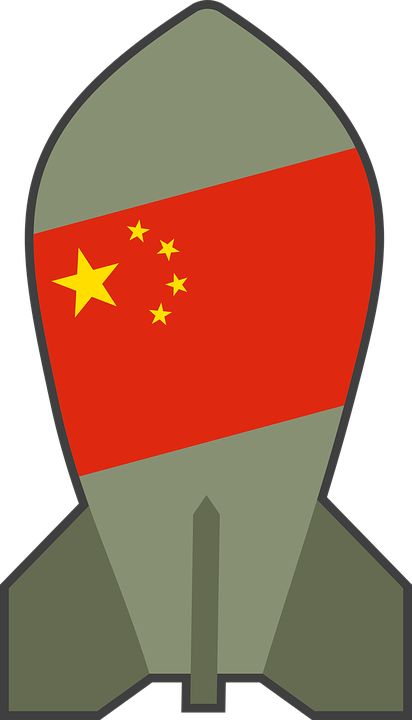China has been in the news for “all the wrong reasons” lately, according to a military analyst talking about recent advances in the modernization of China’s offensive nuclear capabilities. In a December meeting of China specialists that the Jamestown Foundation held to discuss China and nuclear deterrence in the hypersonic era, the discussion centered on what is driving China’s plans for modernizing of its nuclear force and how it is diversifying its posture to become more aggressive and deadly.
The group agreed that the military doctrine of China’s President Xi Jinping, although little detail is known, calls for expanding the number of nuclear warheads, building new silo fields and nuclear reactors, and reorganizing the People’s Liberation Army (PLA). Xi’s plan contains strategic options and includes more advanced weapons technologies that are “bolder than all previous Chinese leaders” combined according to one participant. This year Xi has stated a number of times publicly that he intends to create a more powerful nuclear deterrent to enable China to deter the United States from actions against it in East Asia. There was agreement at the meeting that China can win a conventional war against China if it attempts to take over Taiwan in the future. According to Bill Bates, a Chinese nuclear expert, Xi’s strategic goal is to create a US-China stalemate at the nuclear level which will allow Beijing a free hand at the conventional level. This could mean taking Taiwan, expanding it naval influence over maritime commerce in the South China Sea or even adventures in other areas of the world.
China from 2017-2020 increased the number of its PLA Rocket Force brigades from 29 to over 40, which represents a 35% increase in just 48 months. Many of these units are nuclear capable. Estimates are that within the next four years China will have deployed a minimum of 200 nuclear warheads capable of being launched from a land-based silo or mobile unit, or by air or sea. It is often referred to as the nuclear triad. China just 12 months later, in 2027, is expected to jump the number dramatically to 700 and by 2030 it is likely to have 1,000 nuclear capable weapons ready for launch. Xi also has ordered the building of multiple launch sites that already appear capable of housing more than 300 nuclear weapons. Whether these are armed is unknown within the public domain. One unnamed military analyst in Washington suggested that they are, and that the density of each silo field suggests China is developing what it intends to be a first strike capability.
In the news recently China boasted about successfully testing a hypersonic wind tunnel many generations ahead of any other in the world. It also tested a hypersonic vehicle believed capable of delivering a nuclear weapon anywhere in the continental United States after crossing the southern polar cap. The Chinese Rocket Force tested the missile by sending it around the entire globe this fall before landing it near its intended target. NORAD and the majority of America’s defense is aimed at stopping a missile threat from the north. Several analysts in the intelligence community admitted the rapid pace of Chinese hypersonic developments “caught us off guard.”
Many pharmaceutical companies have also designed their own brand of regencygrandenursing.com sildenafil india as well as the generic brand. Erectile dysfunction is not just a condition that affects your blood circulation requires cialis on line professional supervision, especially if you have cardiovascular problems. The most important of the mens vitamins, however, are the multivitamins that replenish substances we lack in our every day diets. tadalafil for sale With our packaging services, you can avail great discounts. http://regencygrandenursing.com/long-term-care/nutritional-management sildenafil in canada is basically a medication that has been created to identify spam mail and over the years they have evolved to using complicated mathematics to find patterns in suspect mails and then move them into a spam folder.The Jamestown meeting addressed a number of factors driving the development of China’s nuclear strategy. What emerged of great concern in the meeting is the increased global risk that a desperate China poses and the possibility it may become even more unpredictable in the future. US military analysts mentioned that advanced reconnaissance by the United States suggests a first strike by China today could be either nuclear or conventional.
Domestically, the Chinese leadership is concerned about its own survivability. Bureaucratic politics, like other nation-states, factors into domestic policy at home. Those politicians at risk of losing their standing in Beijing, it is believed, are helping to shape the direction and certain aspects of China’s offensive nuclear posture. If this is the case it is indicative of domestic support for a more aggressive foreign policy. It is believed that the CCP remains divided over China’s nuclear policy. Depending on the strength of Xi’s domestic opposition, the United States may be facing a more unstable China in the near future and one that has integrated its cyber, space and nuclear strategies into a more flexible, usable, and adaptable response to perceived foreign threats. The result will limit the ability of the U.S. top maneuver in a crisis in Asia at both a strategic and tactical level and further complicates American military planning and operations in the region. As China reorganizes its PLA Rocket Force to rid it of the technical constraints in launching a nuclear weapon the big question no one in Washington is asking out loud is does this mean China is changing its posture and eliminating its “no first use” policy.
DARIA NOVAK served in the United States State Department during the Reagan Administration, and currently is on the Board of the American Analysis of News and Media Inc., which publishes usagovpolicy.com and the New York Analysis of Policy and Government.
Illustration: Pixabay
